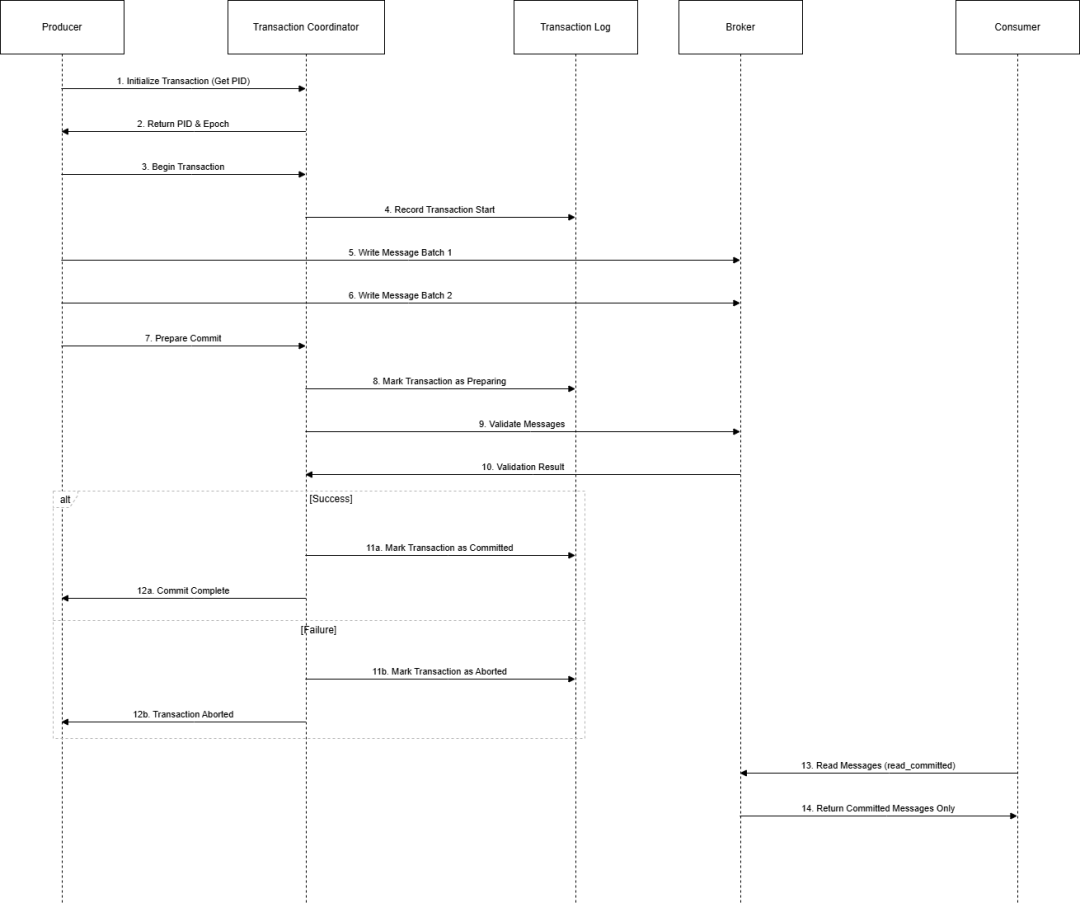
01
事务基础概念
/*** Kafka事务基础概念演示*/public class KafkaTransactionBasics {// 1. 事务生产者配置public static Properties getTransactionalProducerConfig(String transactionalId) {Properties props = new Properties();props.put(ProducerConfig.BOOTSTRAP_SERVERS_CONFIG, "localhost:9092");props.put(ProducerConfig.TRANSACTIONAL_ID_CONFIG, transactionalId);props.put(ProducerConfig.ENABLE_IDEMPOTENCE_CONFIG, true);props.put(ProducerConfig.ACKS_CONFIG, "all");props.put(ProducerConfig.KEY_SERIALIZER_CLASS_CONFIG, StringSerializer.class.getName());props.put(ProducerConfig.VALUE_SERIALIZER_CLASS_CONFIG, StringSerializer.class.getName());return props;}// 2. 基本事务操作示例public static void demonstrateBasicTransaction() {try (KafkaProducer<String, String> producer =new KafkaProducer<>(getTransactionalProducerConfig("basic-transaction-id"))) {// 初始化事务producer.initTransactions();try {// 开始事务producer.beginTransaction();// 发送多条消息producer.send(new ProducerRecord<>("topic1", "key1", "value1"));producer.send(new ProducerRecord<>("topic2", "key2", "value2"));// 提交事务producer.commitTransaction();} catch (Exception e) {// 回滚事务producer.abortTransaction();throw e;}}}// 3. 事务状态监控public static class TransactionStateMonitor {private enum TxState {INIT, BEGUN, PREPARING_COMMIT, COMMITTED, PREPARING_ABORT, ABORTED}private TxState currentState;private final String transactionalId;private final long startTime;public TransactionStateMonitor(String transactionalId) {this.transactionalId = transactionalId;this.startTime = System.currentTimeMillis();this.currentState = TxState.INIT;}public void updateState(TxState newState) {this.currentState = newState;logStateTransition(newState);}private void logStateTransition(TxState newState) {long duration = System.currentTimeMillis() - startTime;System.out.printf("Transaction %s moved to state %s after %d ms%n",transactionalId, newState, duration);}}public static void main(String[] args) {// 演示基本事务操作demonstrateBasicTransaction();}}复制
02
事务实现机制

/*** Kafka事务实现机制详细演示*/public class KafkaTransactionImplementation {// 1. 事务管理器public static class TransactionManager {private final KafkaProducer<String, String> producer;private final TransactionStateMonitor monitor;private final int maxRetries;private final long retryBackoffMs;public TransactionManager(String transactionalId, int maxRetries, long retryBackoffMs) {Properties props = KafkaTransactionBasics.getTransactionalProducerConfig(transactionalId);this.producer = new KafkaProducer<>(props);this.monitor = new TransactionStateMonitor(transactionalId);this.maxRetries = maxRetries;this.retryBackoffMs = retryBackoffMs;// 初始化事务producer.initTransactions();}// 2. 执行事务性操作public void executeTransactionally(List<ProducerRecord<String, String>> records) {int attempts = 0;while (attempts < maxRetries) {try {executeTransaction(records);return;} catch (Exception e) {attempts++;if (attempts == maxRetries) {throw new RuntimeException("Max retries exceeded", e);}sleep(retryBackoffMs * (1L << attempts));}}}// 3. 具体的事务执行逻辑private void executeTransaction(List<ProducerRecord<String, String>> records) {try {producer.beginTransaction();monitor.updateState(TransactionStateMonitor.TxState.BEGUN);// 发送所有消息for (ProducerRecord<String, String> record : records) {producer.send(record, (metadata, exception) -> {if (exception != null) {throw new RuntimeException("Failed to send record", exception);}});}monitor.updateState(TransactionStateMonitor.TxState.PREPARING_COMMIT);producer.commitTransaction();monitor.updateState(TransactionStateMonitor.TxState.COMMITTED);} catch (Exception e) {monitor.updateState(TransactionStateMonitor.TxState.PREPARING_ABORT);producer.abortTransaction();monitor.updateState(TransactionStateMonitor.TxState.ABORTED);throw e;}}// 4. 资源清理public void close() {if (producer != null) {producer.close();}}private void sleep(long ms) {try {Thread.sleep(ms);} catch (InterruptedException e) {Thread.currentThread().interrupt();throw new RuntimeException(e);}}}// 5. 演示使用public static void main(String[] args) {TransactionManager manager = new TransactionManager("transaction-demo-id", 3, 100);List<ProducerRecord<String, String>> records = Arrays.asList(new ProducerRecord<>("topic1", "key1", "value1"),new ProducerRecord<>("topic2", "key2", "value2"));try {manager.executeTransactionally(records);} finally {manager.close();}}}复制
03
事务消费者实现
/*** Kafka事务消费者实现示例*/public class TransactionalConsumerProducer {private final KafkaConsumer<String, String> consumer;private final KafkaProducer<String, String> producer;private final String consumerGroupId;private volatile boolean running = true;public TransactionalConsumerProducer(String transactionalId, String consumerGroupId) {this.consumerGroupId = consumerGroupId;// 1. 配置消费者Properties consumerProps = new Properties();consumerProps.put(ConsumerConfig.BOOTSTRAP_SERVERS_CONFIG, "localhost:9092");consumerProps.put(ConsumerConfig.GROUP_ID_CONFIG, consumerGroupId);consumerProps.put(ConsumerConfig.ISOLATION_LEVEL_CONFIG, "read_committed");consumerProps.put(ConsumerConfig.ENABLE_AUTO_COMMIT_CONFIG, "false");consumerProps.put(ConsumerConfig.KEY_DESERIALIZER_CLASS_CONFIG,StringDeserializer.class.getName());consumerProps.put(ConsumerConfig.VALUE_DESERIALIZER_CLASS_CONFIG,StringDeserializer.class.getName());// 2. 配置生产者Properties producerProps = new Properties();producerProps.put(ProducerConfig.BOOTSTRAP_SERVERS_CONFIG, "localhost:9092");producerProps.put(ProducerConfig.TRANSACTIONAL_ID_CONFIG, transactionalId);producerProps.put(ProducerConfig.ENABLE_IDEMPOTENCE_CONFIG, true);producerProps.put(ProducerConfig.KEY_SERIALIZER_CLASS_CONFIG,StringSerializer.class.getName());producerProps.put(ProducerConfig.VALUE_SERIALIZER_CLASS_CONFIG,StringSerializer.class.getName());this.consumer = new KafkaConsumer<>(consumerProps);this.producer = new KafkaProducer<>(producerProps);this.producer.initTransactions();}// 3. 消费-处理-生产循环public void processMessages(String inputTopic, String outputTopic) {consumer.subscribe(Collections.singletonList(inputTopic));try {while (running) {ConsumerRecords<String, String> records =consumer.poll(Duration.ofMillis(100));if (!records.isEmpty()) {processRecordBatch(records, outputTopic);}}} finally {closeResources();}}// 4. 处理消息批次private void processRecordBatch(ConsumerRecords<String, String> records,String outputTopic) {try {producer.beginTransaction();// 处理每条消息for (ConsumerRecord<String, String> record : records) {String processedValue = processRecord(record.value());ProducerRecord<String, String> outputRecord =new ProducerRecord<>(outputTopic, record.key(), processedValue);producer.send(outputRecord);}// 提交消费偏移量Map<TopicPartition, OffsetAndMetadata> offsets = new HashMap<>();for (TopicPartition partition : records.partitions()) {List<ConsumerRecord<String, String>> partitionRecords =records.records(partition);long lastOffset = partitionRecords.get(partitionRecords.size() - 1).offset();offsets.put(partition, new OffsetAndMetadata(lastOffset + 1));}// 在事务中提交偏移量producer.sendOffsetsToTransaction(offsets,new ConsumerGroupMetadata(consumerGroupId));// 提交事务producer.commitTransaction();} catch (Exception e) {producer.abortTransaction();throw new RuntimeException("Failed to process record batch", e);}}// 5. 业务处理逻辑private String processRecord(String value) {// 实现具体的业务处理逻辑return "Processed: " + value;}private void closeResources() {producer.close();consumer.close();}public void shutdown() {running = false;}}复制
04
加群请添加作者

05
获取文档资料

推荐阅读系列文章
建议收藏 | Dinky系列总结篇 建议收藏 | Flink系列总结篇 建议收藏 | Flink CDC 系列总结篇 建议收藏 | Doris实战文章合集 建议收藏 | Paimon 实战文章总结 建议收藏 | Fluss 实战文章总结 建议收藏 | Seatunnel 实战文章系列合集 建议收藏 | 实时离线输数仓(数据湖)总结篇 建议收藏 | 实时离线数仓实战第一阶段总结 超700star!电商项目数据湖建设实战代码 ,拿来即用! 从0到1建设电商项目数据湖实战教程 推荐一套开源电商项目数据湖建设实战代码
如果喜欢 请点个在看分享给身边的朋友
文章转载自大数据技能圈,如果涉嫌侵权,请发送邮件至:contact@modb.pro进行举报,并提供相关证据,一经查实,墨天轮将立刻删除相关内容。






